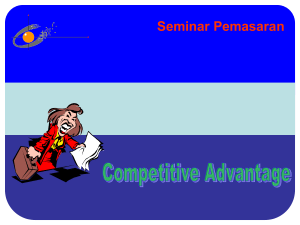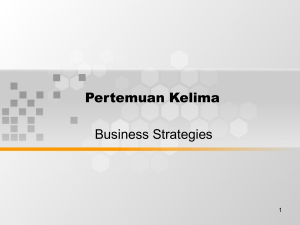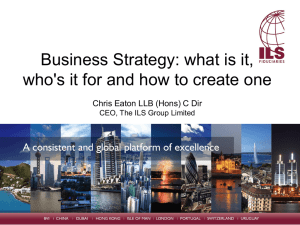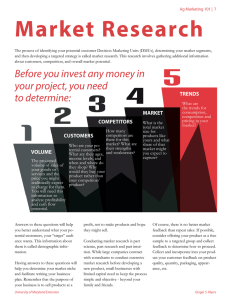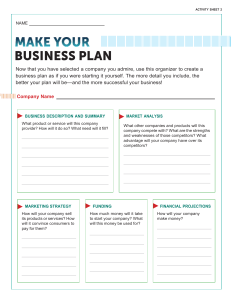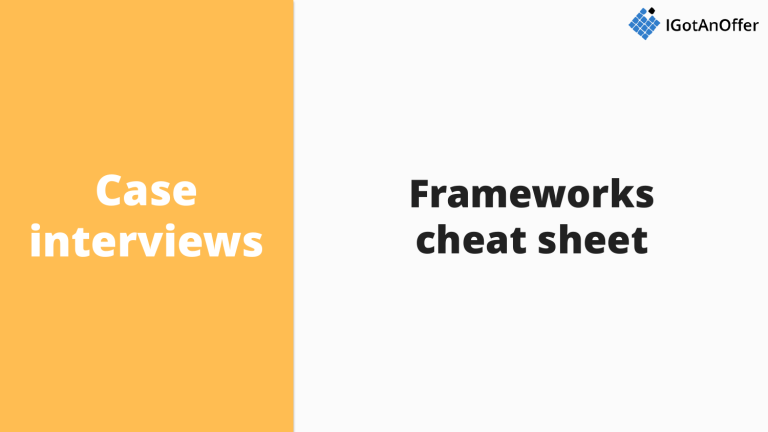
Case interviews Frameworks cheat sheet Profitability framework Useful revenue segmentation Volume 1 • • • • Revenues Price per unit By product type By distribution channel By geography By customer type Profits Fixed costs examples: Fixed costs Costs Volume • Rent • Staff overhead • Loan interest Variable costs examples: Variable costs Cost / unit • • • • Raw materials Delivery Commission Direct labour 4Ps framework Product 2 Price Promotion • Customer need fulfilled • Perceived value for customer • Marketing messages • Usage (who, where, how, etc.) • Competitor prices • Media type (E.g. TV, Facebook, etc.) • Good vs. service • Product lifecycle (new vs. mature) • Substitutes • Etc. • Customer price sensitivity • Production cost • Etc. • Best time to promote (E.g. Halloween) Place • Possible channel (E.g. physical, website, etc.) • Customer expectation • Requirement for a sales team? • Competitors’ strategies • Competitors’ strategies • Etc. • Etc. Porter’s 5 forces 3 Bargaining power of customers Bargaining power of suppliers • Customer concentration (E.g. top 3 as % revenues) • Supplier concentration (E.g. top 3 as % revenues) • Potential new substitutes • Price sensitivity • Cost of switching from one supplier to another • Evolution of customer propensity to substitute • Information availability • Supplier differentiation Threat of substitutes • Ease of substitution Threat of new entrants Existing rivals • Regulation authorisations required • Number of competitors and market share • Capital requirements • Similarity between products • Economies of scale • Network effects • Financial health of competitors 3Cs framework Customers 4 Competition Company • Customer demographics (E.g. age, sex, income, etc.) • Competitors’ value proposition and brand • Product offering • Customer needs • Competitors’ market share and growth • Core competencies • Customer segments’ size and growth rates • Customer willingness to pay and price sensitivity • Competitors’ financial health • Profitability • Unique selling point • Financial performance and resources Market entry framework Market 5 • Market size Client capabilities • Market profitability • Differences between client’s current and new market • Competition intensity • Is it the client’s first new market entry? • Market regulation • Have other companies entered already? • Product types Financials • Current financial situation of the client • Cost to enter new market • Ongoing costs once market entered • Expected revenues and ROI Entry strategy • Ideal timing of market entry • Do a test in a region first? • Build own company, buy competitor or do JV? • Control from head office or decentralise? Pricing framework Cost-based 6 • Fixed costs • Variable costs • Number of units sold annually • Profitability targeted Value-based Competitor-based • Price of next best alternative to product offered • Available substitutes from competition • Features that makes product better than next best alternative • Price of these substitutes • Value of these features • Value of our product vs. substitutes Overall strategy • Pricing strategy objective? High profitability, win market share, etc. • Cross-sell / upsell opportunities to take into account • Possibility to sell different versions of the same product? Merger and acquisition framework The market 7 The target • Are both companies in the same market? • Current / future financial position of the target • Market size and growth • Important assets and capabilities owned by target • Market profitability • Competition intensity • Market regulation • Quality of target’s management team • Culture of target company vs. buyer The buyer • Acquisition rationale: undervaluation, control or synergies • Acquisition financing • Does buyer have experience with other acquisitions? • Right time to make acquisition? Synergies and risks • Value of individual and combined entities • Cost synergies • Revenue synergies • Biggest risks of failure Warning Do NOT reuse existing frameworks in your interviews Warning Your interviewer will recognise them and penalise you Warning Learn to put your own frameworks together instead Structured training More than 80% success rate
